VMware vRealize Operations 6.x has been removed from general support, for more information review the VMware Lifecycle Matrix. See also How to Install vRealize Operations 8.x.
The vRealize product suite is a complete, enterprise, cloud management and automation platform for private, public, and hybrid clouds. Specifically vRealize Operations Manager provides intelligent operations management across heterogeneous physical, virtual, and cloud environments from a wide range of vendors. vRealize Operations Manager is able to deliver proactive and automated performance improvements by implementing resource reclamation, configuration standardisations, workload placement, planning, and forecasting techniques. By leveraging vRealize Operations Manager users can protect their environment from outages with preventative and predictive analytics and monitoring across the estate; utilising management packs to unify operations management. The image below is taken from the vRealize Operations Manager datasheet.
vRealize Operations Manager can be deployed as a single node cluster, or a multiple node cluster. In single node cluster environments the master node is deployed with adapters installed which collect data and perform analysis. For larger environments additional data nodes can be added to scale out the solution, these are known as multiple node clusters. In a multiple node cluster the master node is responsible for the management of all other nodes. Data nodes handle data collection and analysis. High availability can be achieved by converting a data node into a replica of the master node. For distributed environments remote collector nodes are deployed to gather inventory objects and navigate firewalls in remote locations. These nodes do not store data or perform analytics; you can read more about remote collector nodes here. In this post we will deploy a single node cluster for small environments, proof of concept, test, or lab purposes, and link it to a vCenter Server instance. There will also be references to larger deployments and scaling out the application throughout the guide. If you have already deployed your vRealize cluster and want to add additional nodes or configure High Availability click here.
Licensing is split out into 3 editions; standard, advanced, and enterprise. To view the full feature list of the different editions see the vRealize Operations page. There are a number of VMware product suites bundling vRealize Operations, or it can be purchased standalone. Licensing is allocated in portable license units (vCloud suite and vRealize suite only), per processor with unlimited VMs, or in packs of 25 VMs (or OS instances).
Design Considerations
- Additional data nodes can be added at any time using the Expand an Existing Installation option.
- When scaling out the cluster by 25% or more the cluster should be restarted to optimise performance.
- The master node must be online before any other nodes are brought online (except for when adding nodes at first setup of the cluster).
- When adding additional data nodes keep in mind the following:
- All nodes must be running the same version
- All nodes must use the same deployment type, i.e. virtual appliance, Windows, or Linux.
- All nodes must be sized the same in terms of CPU, memory, and disk.
- Nodes can be in different vSphere clusters, but must be in the same physical location and subnet.
- Time must be synchronised across all nodes.
- These rules also apply to replica nodes. Click here to see a full list of multiple node cluster requirements.
- Remote collector nodes can be deployed to remote locations to gather objects for monitoring. These nodes do not store data or perform any analytics but connect remote data sources to the analytics cluster whilst reducing bandwidth and providing firewall navigation. Read more about remote collector nodes here.
- When designing a larger vROps environment check the Environment Complexity guide to determine if you should engage VMware Professional Services. You should also review the following documentation:
Requirements
- The vRealize Operations Manager virtual appliance can be deployed to hosts running ESXi 5.1 U3 or later, and requires vCenter Server 5.1 U3 or later (it is recommended that vSphere 5.5 or later is used).
- The virtual appliance is the preferred deployment method, a Windows and Linux installer is also available however the Windows installer will no longer be offered after v6.4, and end of life for the Linux installer is also imminent.
- A static IP address must be used for each node (to change the IP after deployment see this kb).
- Review the list of Network Ports used by vRealize Operations Manager.
- The following table is from the vRealize Operations Manager Sizing Guide and lists the hardware requirements, latency, and configuration maximums.

Installation
Download vRealize Operations Manager here, in virtual appliance, Windows, or Linux formats. Try for free with hands on labs or a 60 day trial here.
In this example we are going to deploy as an appliance. Navigate to the vSphere web client home page, click vRealize Operations Manager and select Deploy vRealize Operations Manager.
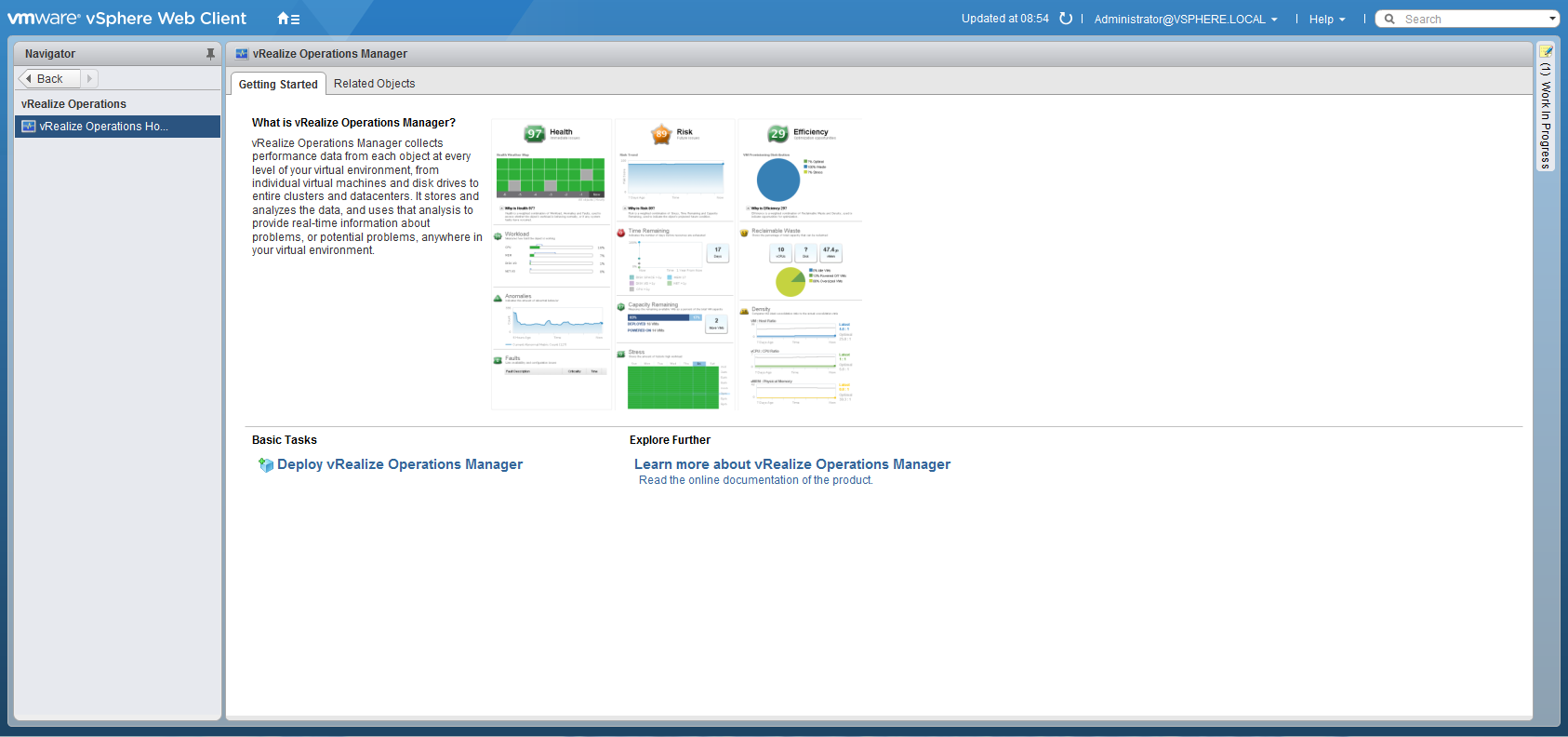
The OVF template wizard will open. Browse to the location of the OVA file we downloaded earlier and click Next.
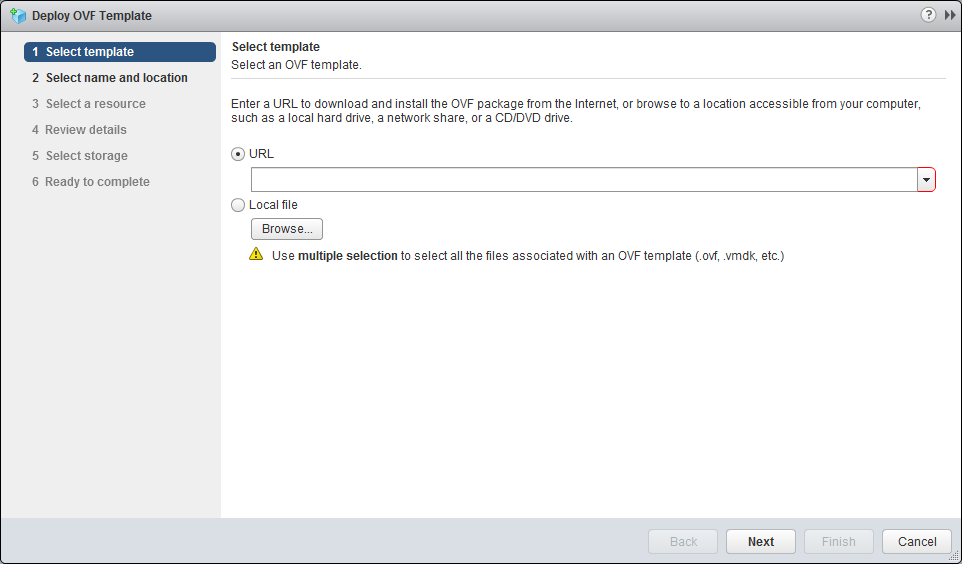
Enter a name for the virtual appliance, and select a location. Click Next.

Select the host or cluster compute resources for the virtual appliance and click Next.
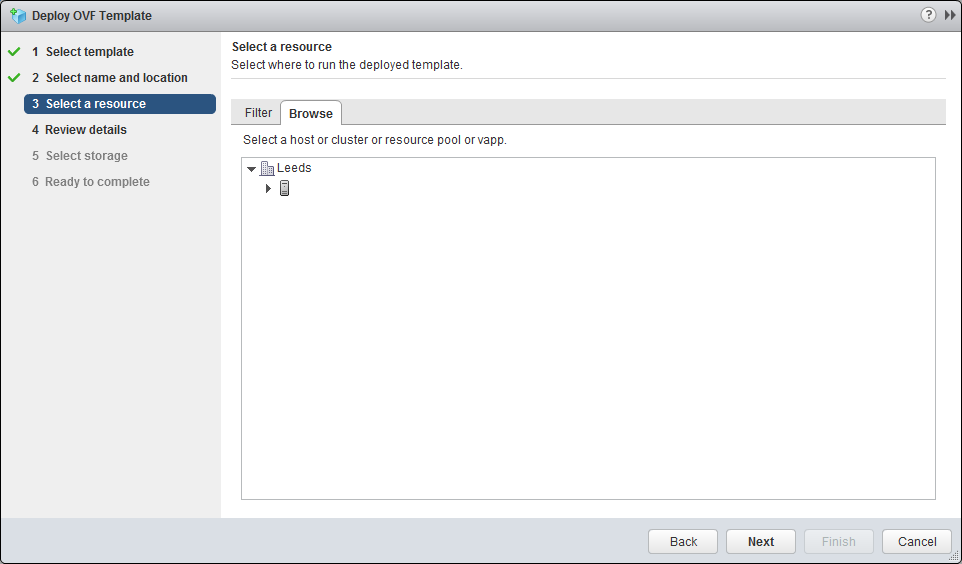
Review the details of the OVA, click Next.
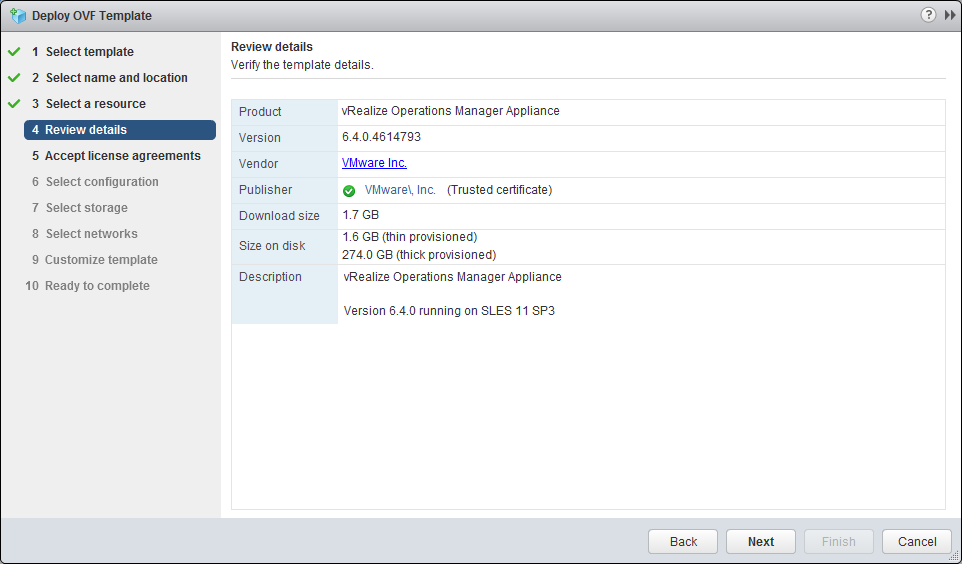
Accept the EULA and click Next.

Select the configuration size based on the considerations listed above, then click Next.

Select the storage for the virtual appliance, click Next.
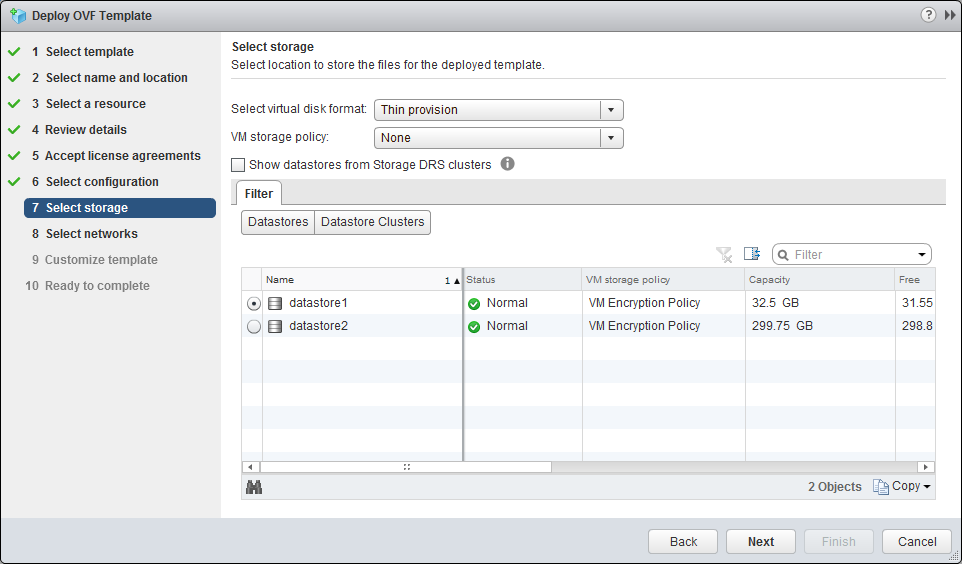
Select the network for the virtual appliance, click Next.

Configure the virtual appliance network settings, click Next.
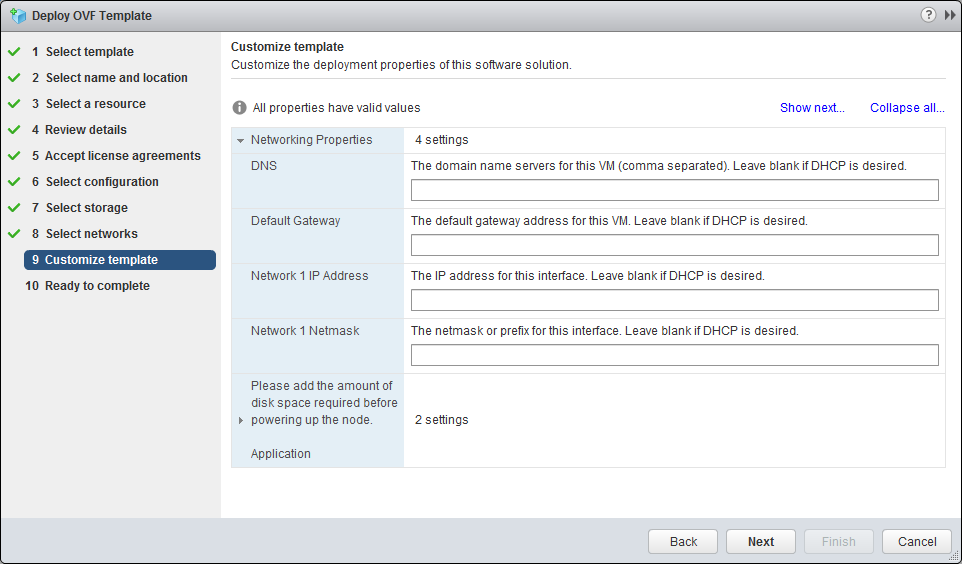
Click Finish on the final screen to begin deploying the virtual appliance.
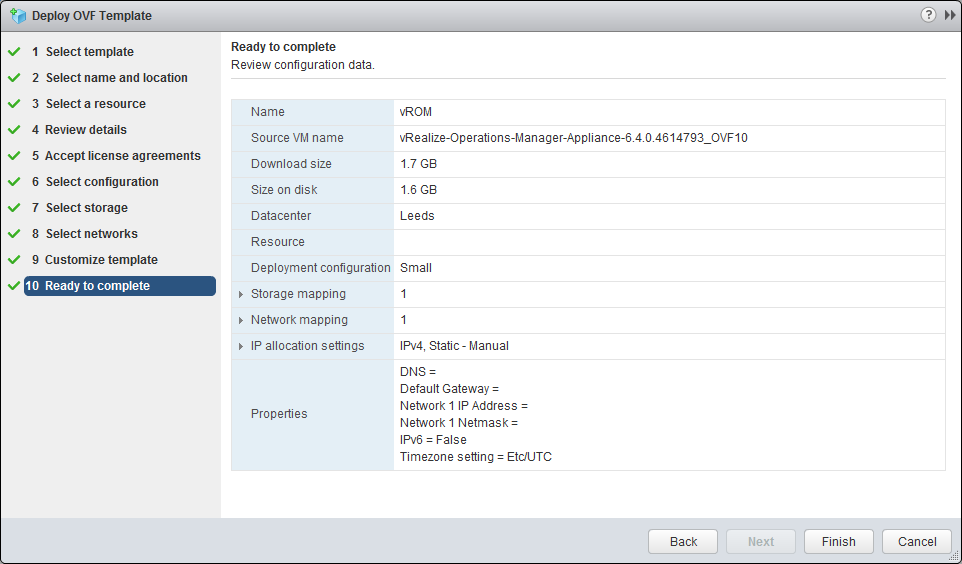
Setup
Once the virtual appliance has been deployed and is powered on, open a web browser to the FQDN or IP address configured during deployment. Select New Installation.

Click Next to begin the setup wizard.
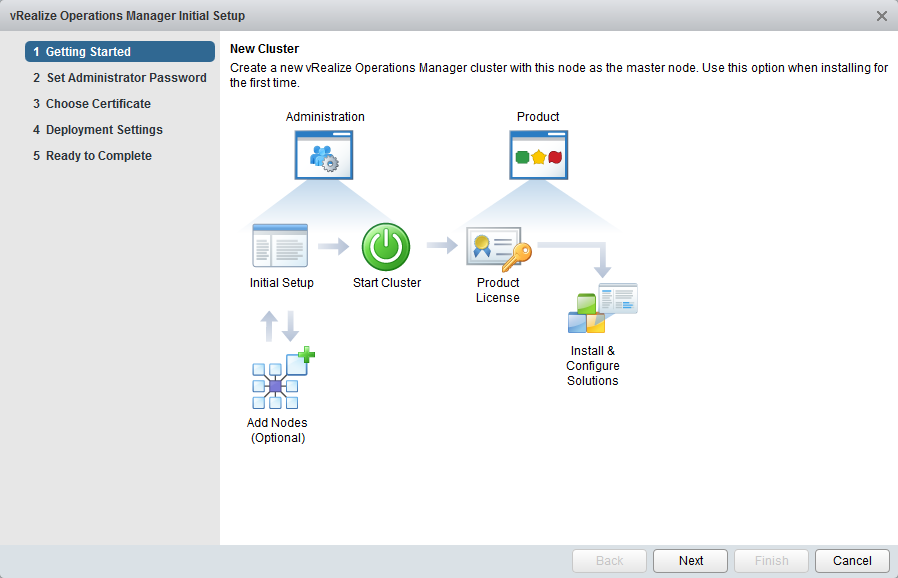
Configure a password for the admin account and click Next.
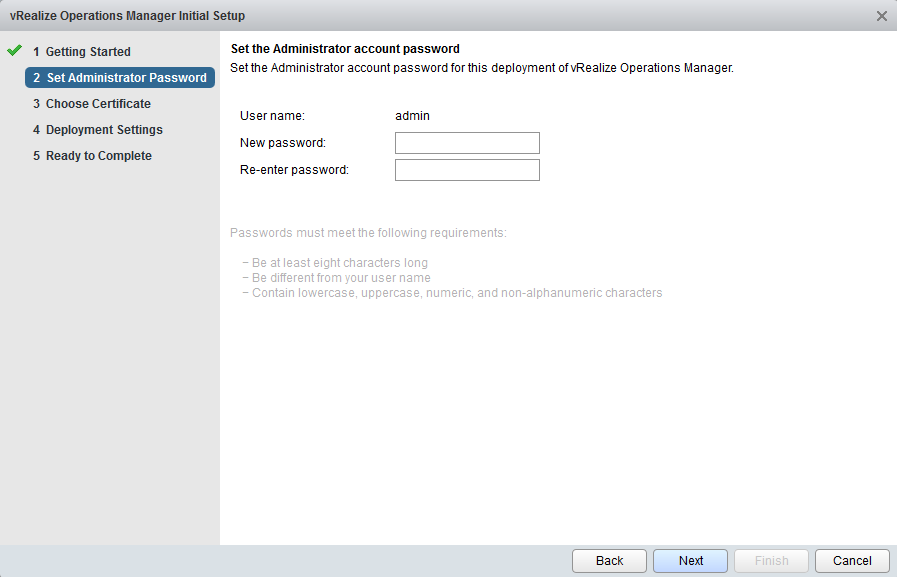
On the certificate page select either the default certificates or custom. For assistance with adding custom certificates click here.
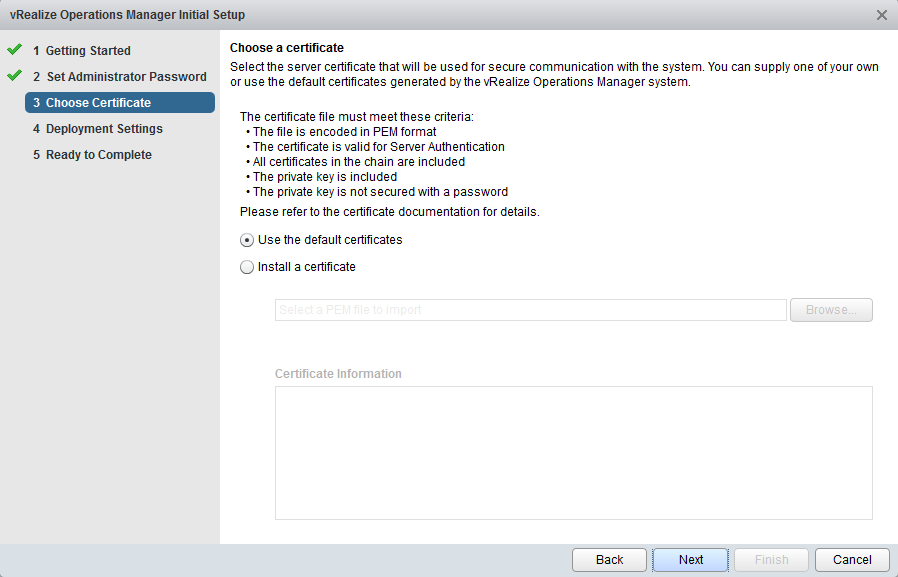
Enter the host name for the master node and an NTP server, click Next.
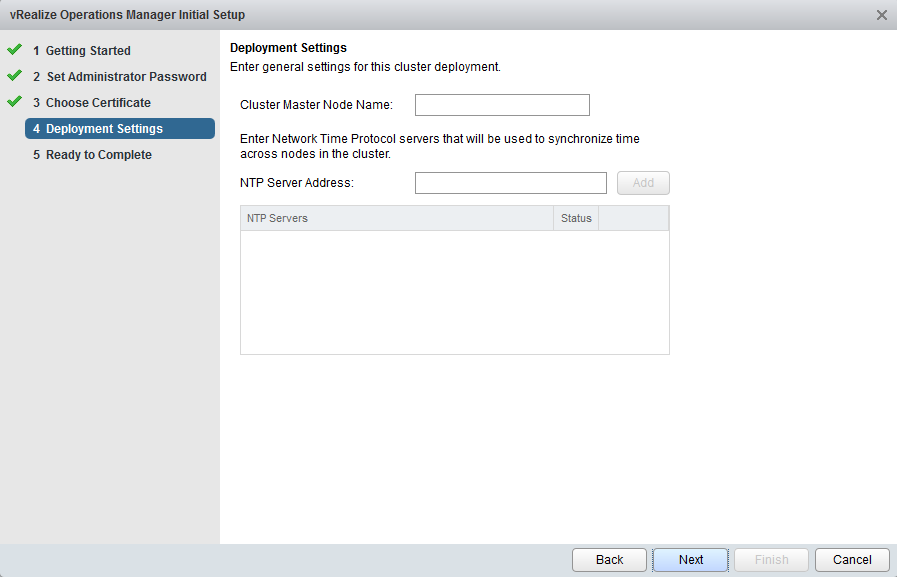
Click Finish.
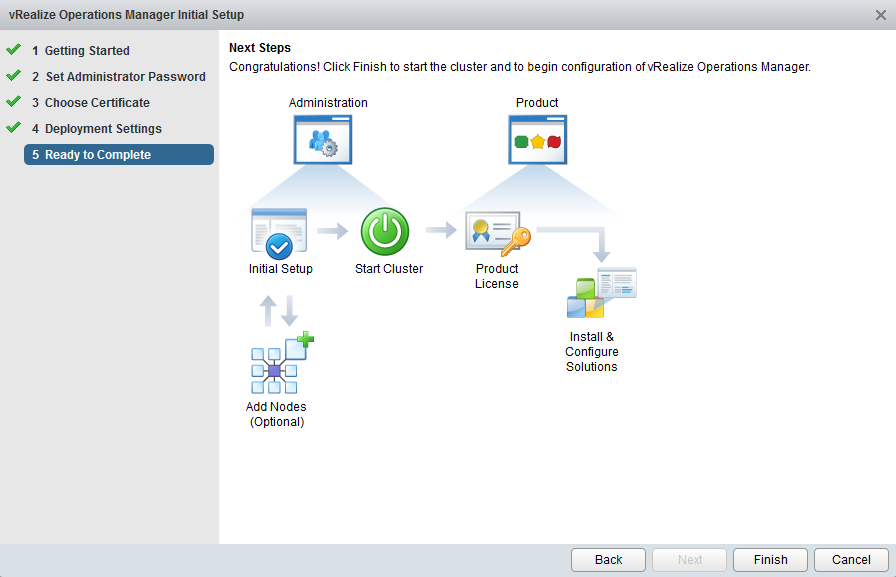
If required you can add additional data nodes before starting the cluster, or add them at a later date. See the Design Considerations section of this post before scaling out. To add additional data nodes or configure High Availability follow the steps at vRealize Operations High Availability before starting the cluster. Alternatively, you can start the cluster as a single node cluster and add data nodes or High Availability at a later date.
Since we are deploying a single node cluster we will now click Start vRealize Operations Manager. Depending on the size of the cluster it may take 10-30 minutes to fully start up.

Confirm that the cluster has adequate nodes for the environment and click Yes to start up the application.

After the cluster has started you will be diverted to the user interface. Log in with the admin details configured earlier.
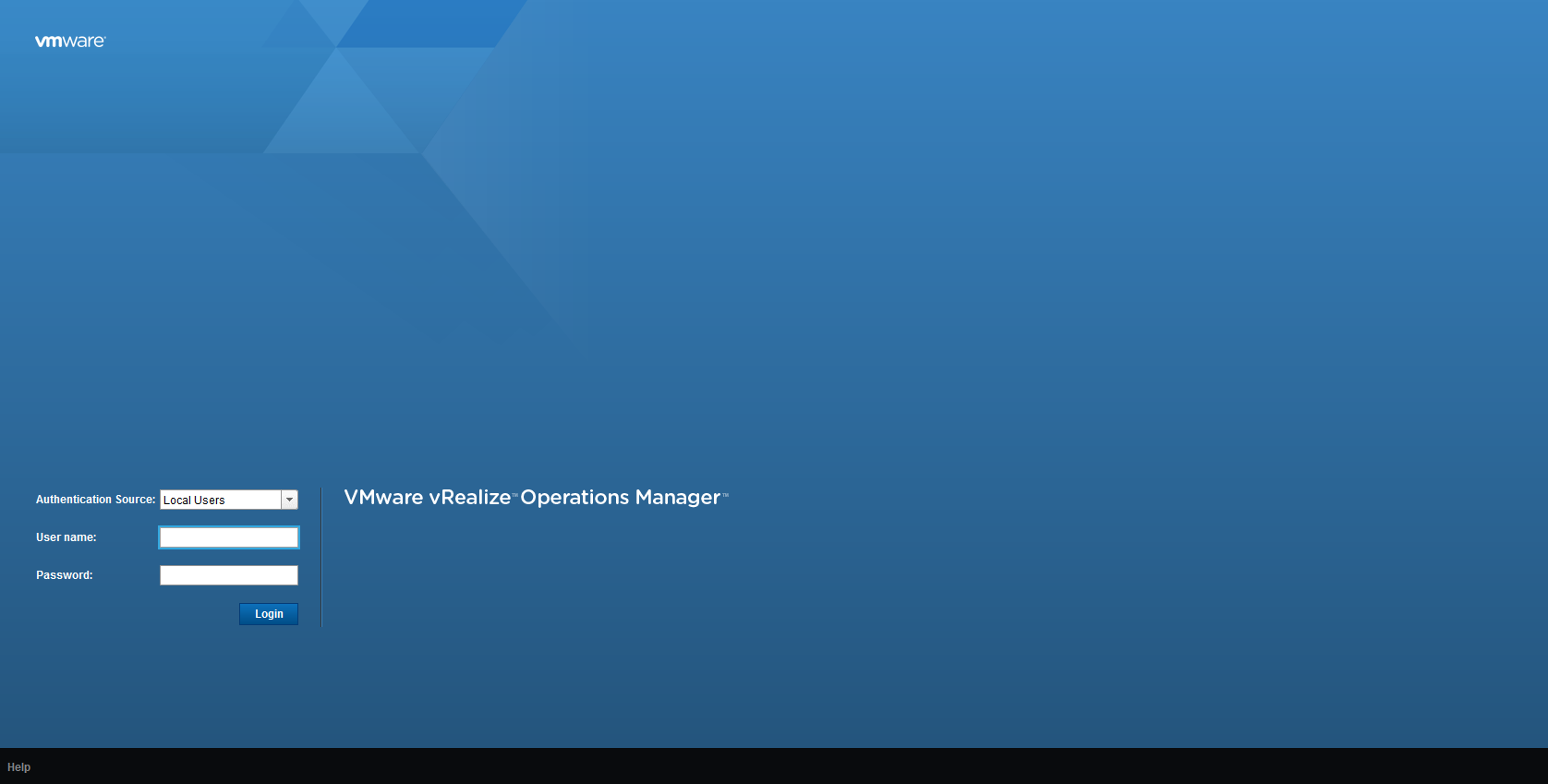
The configuration wizard will automatically start, click Next.

Accept the EULA and click Next.

Enter the license key or use the 60 day product evaluation. Click Next.
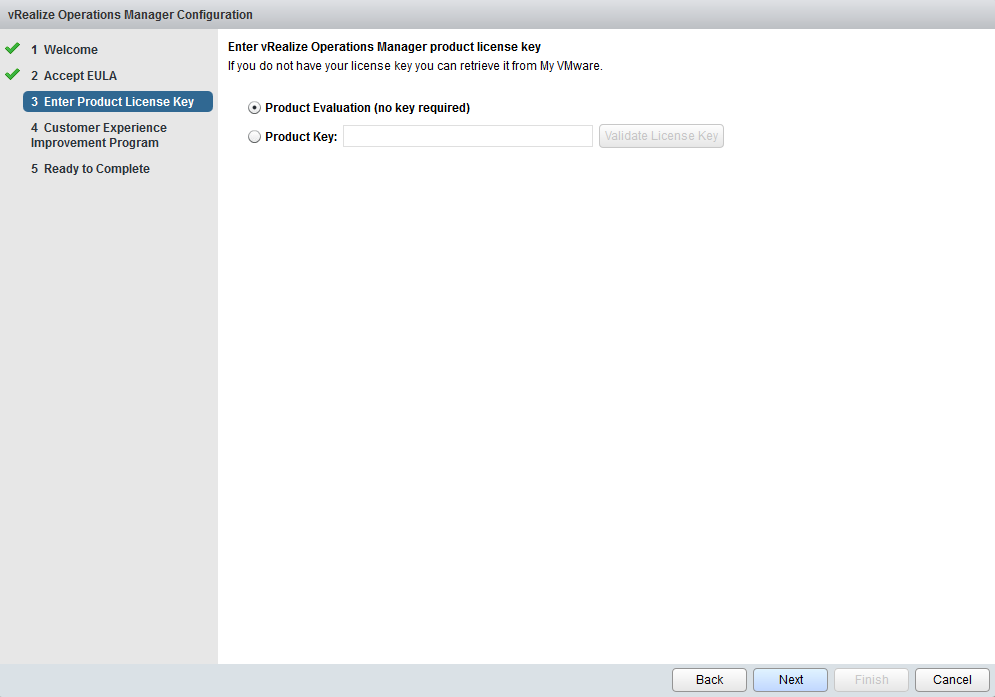
Select whether or not to join the VMware Customer Experience Improvement Program and click Next.
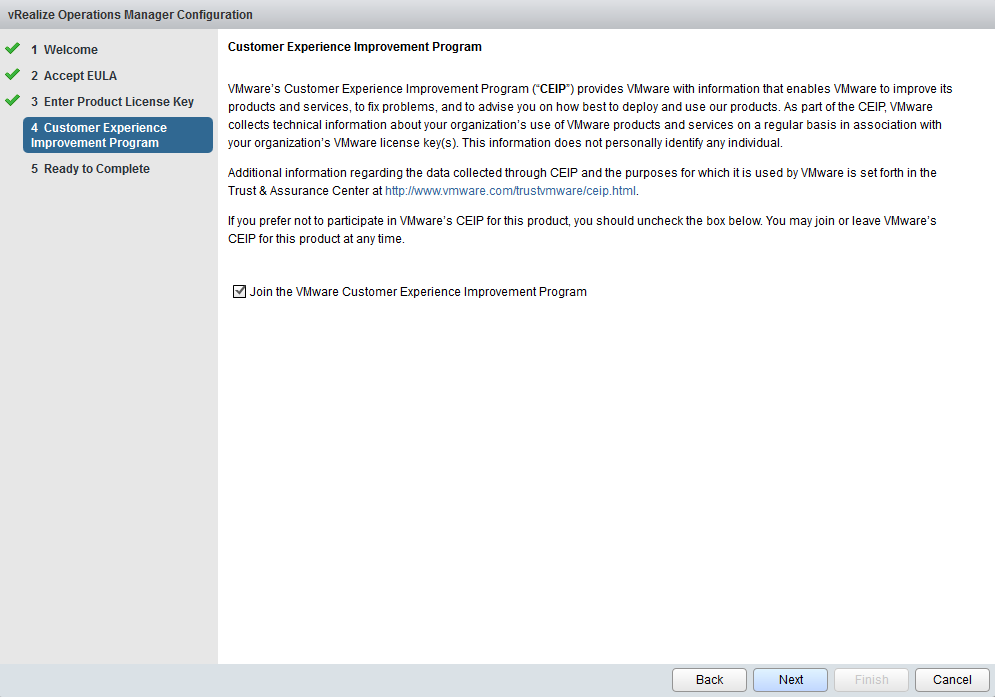
Click Finish.
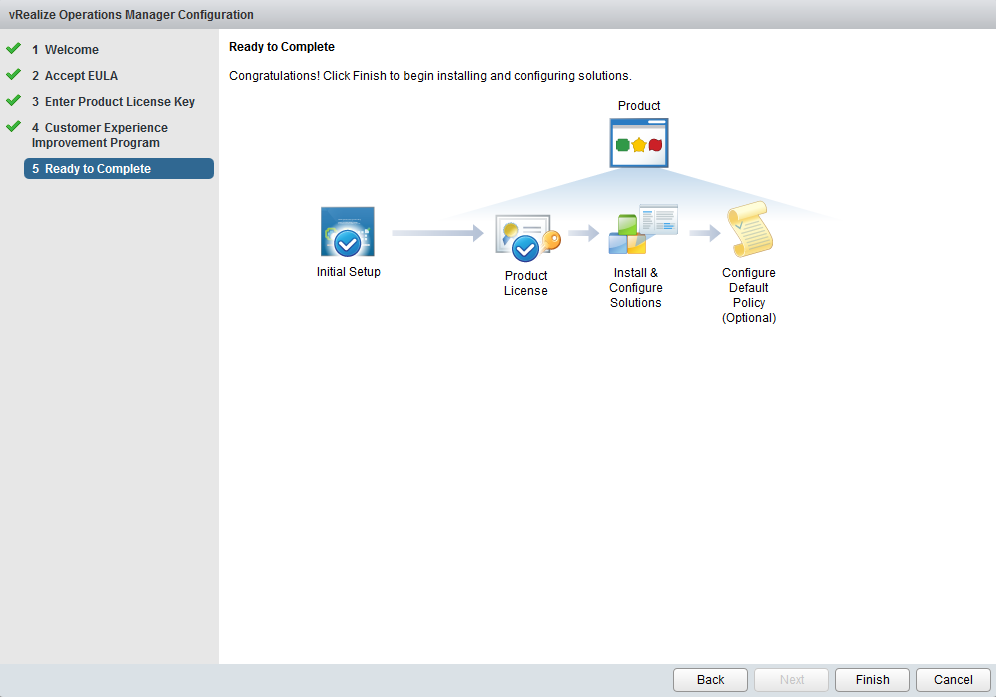
The vRealize Operations Manager dashboard will be loaded. The installation process is now complete. The admin console can be accessed by browsing to http:///admin where is the IP address of FQDN of your vRealize Operations Manager appliance or server.
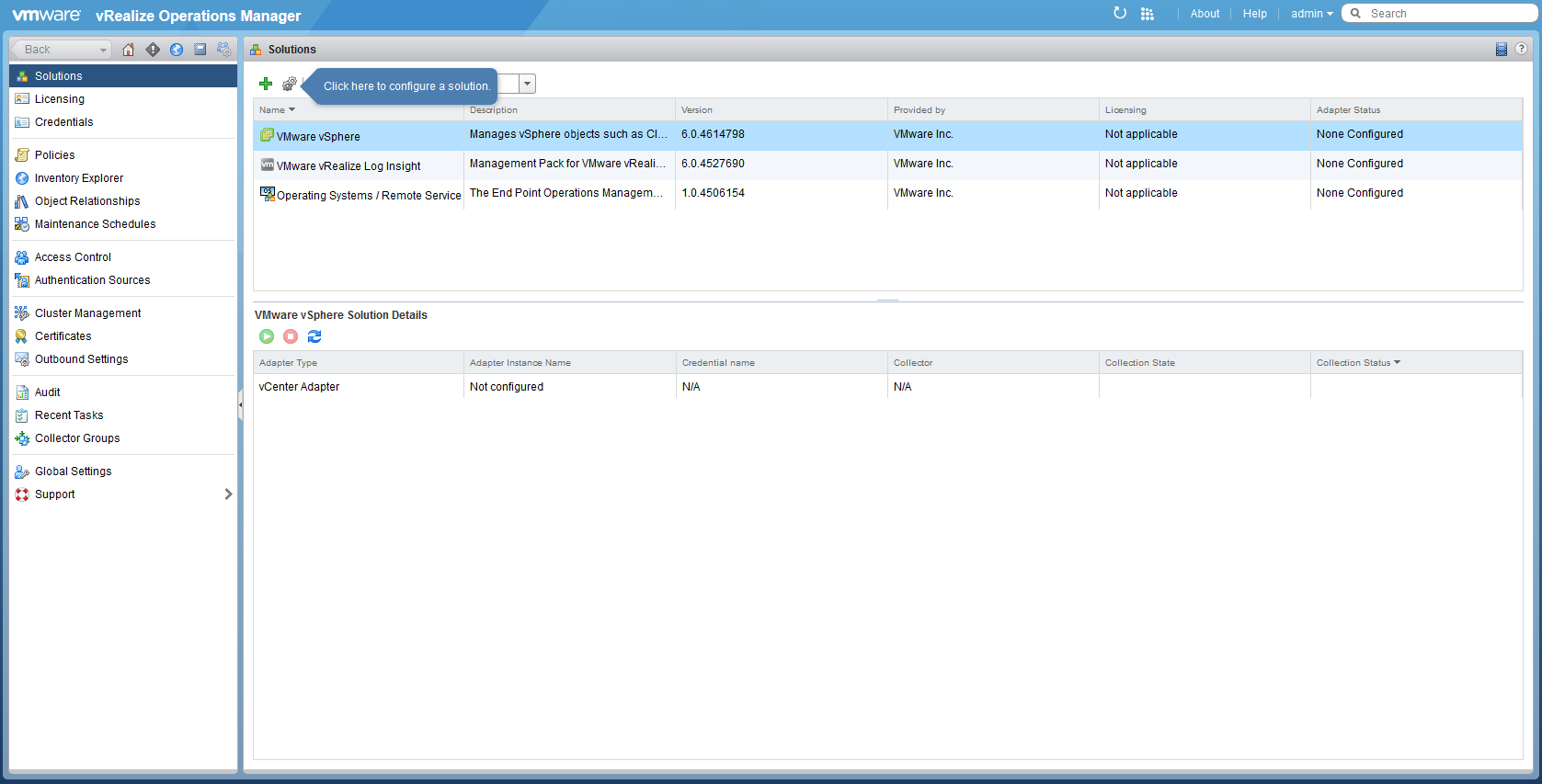
To add additional data nodes or configure High Availability see the vRealize Operations High Availability post.
Post Installation
After first setup we need to secure the console by creating a root account. Browse to the vROps appliance in vSphere and open the console. Press ALT + F1 and log in as root. You will be prompted to create a root password. All other work in this post is carried out using the vRealize Operations web interface.
The vRealize Operations web interface can be accessed by browsing to the IP address or FQDN of any node in the vRealize Operations management cluster (master node or replica node). During the installation process the admin interface is presented, after installation the IP address or FQDN resolves to the user interface. To access the admin interface browse to https:///admin where is the IP address or FQDN of either node in the management cluster. For supported browsers see the vRealize Operations Manager 6.4 Release Notes.
The next step is to configure the vCenter Adapter to collect and analyse data. Select Administration from the left hand navigation pane. From the Solutions menu select VMware vSphere and click the Configure icon.

Enter the vCenter Server details and credentials with administrator access.

Click Test Connection to validate connectivity to the vCenter Server.
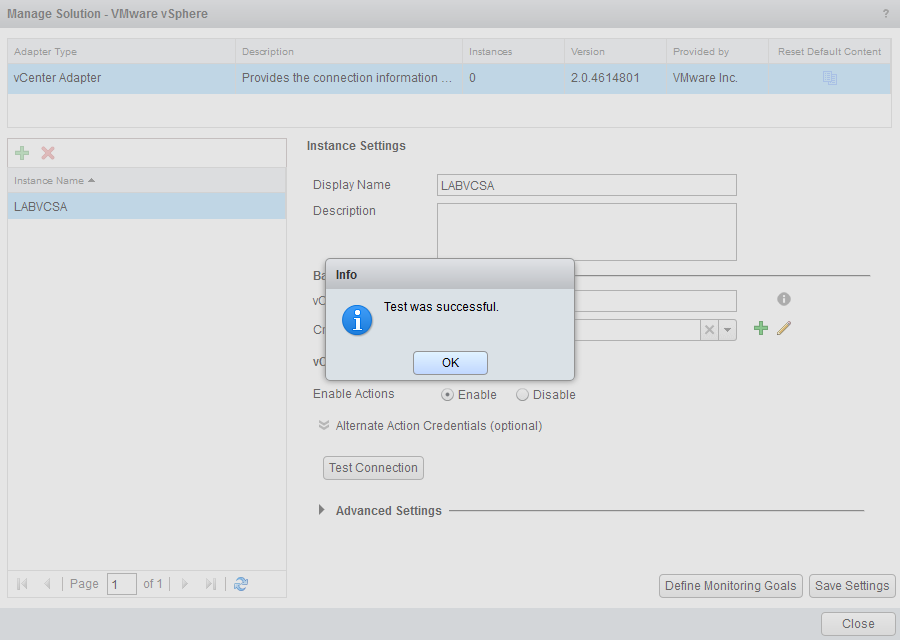
Expand Advanced Settings and review the default settings, these can be changed if required. Click Define Monitoring Goals and review the default policy, again this can be changed to suit your environment.
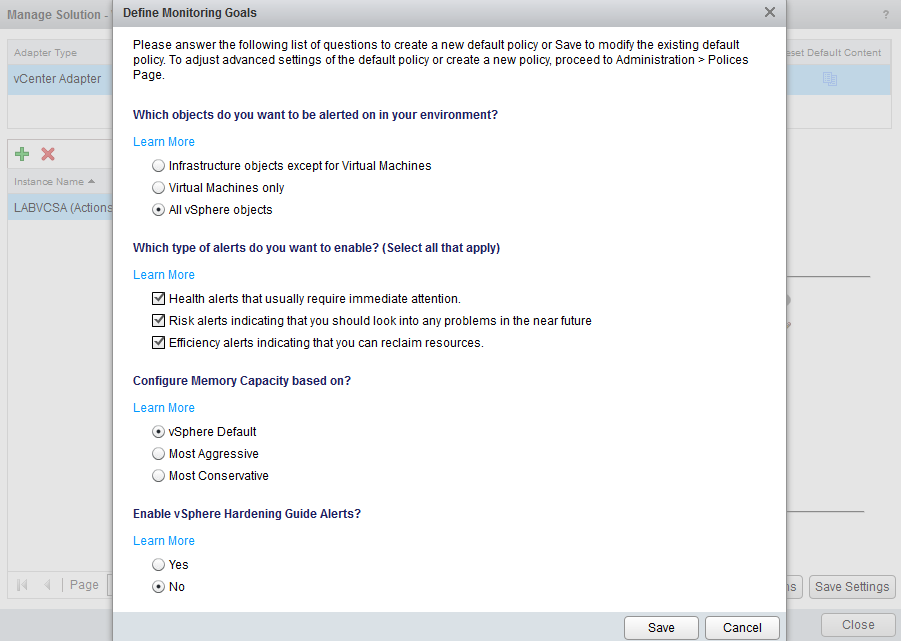
When you’re ready click Save Settings and Close. The vCenter adapter will now begin collecting data. Collection cycles begin every 5 minutes, depending on the size of your environment the initial collection may take more than one cycle.

Once data has been collected from the vCenter Server go back to the Home page and browse the different tabs and dashboards.

Customise your vRealize Operations Manager instance to suit you environment using the VMware guides below.

Hi !
Awesome article. I tried installing in my lab environment. It was successfully deployed. However when I powered it on and opened console, it got stuck at a point called – install.sh or it ended with a blue+grey half screen which was blank. Despite the error, I tried logging in by typing the IP /FQDN which I had used during deployment but no luck. Can you pls help me? I am at my wits end…
LikeLiked by 1 person
Hello, have you tried re-downloading and re-deploying the appliance? Does the appliance have full internet access? https://kb.vmware.com/s/article/2150424
LikeLiked by 1 person
Hi! Thanks for this great article.
I have deployed an installation of vcenter server 5.5 u3 and some ESXi 5.5 u3.
What about if I’m instaling this 6.4 version of vrealize operations manager, regarding license???
We’ve support and maintenance from vmware, but we didn’t upgrade the licenses yet.
Is this possible?
LikeLiked by 1 person
Select product evaluation on the license page. I don’t know what the grace period is, it’s normally 30 or 60 days.
LikeLiked by 1 person
You can put the license in later.
LikeLiked by 1 person